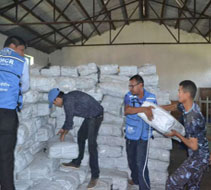
UNHCR, the UN refugee agency, is sending thousands of plastic sheets and solar-powered lamps to people left homeless and without light by the devastating earthquake in Nepal.
The quake that happened on 23 May, recorded at 7.8 on the open-ended Richter scale, left around 4,000 people dead in Nepal as well as in India, Tibet and Bangladesh that were affected as a result of the earthquake. Nepalese officials say more than 7,000 were injured. Well over 1,000 of the victims were from Kathmandu and the surrounding areaa. The numbers are expected to rise as search-and-rescue teams reach remote villages.
UNHCR said it is responding to a government call for help by sending 11,000 plastic sheets and 4,000 solar-powered lanterns from its warehouse in Damak, eastern Nepal, to the eastern hilly districts of Ramechhap, Okhaldhunga and Sindhuli.
Meanwhile, an additional 8,000 plastic sheets and 4,000 solar lamps were flown to Kathmandu from Dubai on a cargo flight provided free of charge by Dubai's ruler, Sheikh Mohammed bin Rashid Al Maktoum. The plastic sheets will be used to construct or repair shelters and the lamps will provide light at night.
It is estimated that tens of thousands of people have lost their homes and are living in the open or in tent settlements. People have also been spending their nights outdoors, fearing that damaged buildings could collapse if there are more aftershocks.
Meanwhile, rescue and aid workers in Nepal are struggling to find survivors by digging through rubble by hand and performing surgeries in makeshift operating theatres, hindered by power blackouts in Kathmandu, with supply shortages and difficulties in getting around in what is one of South Asia’s poorest countries.
The earthquake spread from Kathmandu to small villages and to the slopes of the world’s highest peak Mount Everest, triggering an avalanche that buried part of the base camp packed with foreign climbers preparing to climb the mountain. It killed at least 18 climbers.
Centuries-old buildings were also destroyed at UNESCO World Heritage sites in the Kathmandu Valley, including some at the Kathmandu Durbar Square. The capital city is made up of small, poorly constructed brick buildings and the earthquake destroyed some of the oldest neighborhoods, but left a few modern structures standing.
The earthquake was the worst to hit Nepal in more than 80 years and was strong enough to be felt all across parts of India, Bangladesh, Tibet and Pakistan. Nepal's worst recorded earthquake was in 1934 and measured 8 on the Richter scale. It destroyed the cities of Kathmandu, Bhaktapur and Patan.
The recent earthquake has put a huge strain on the resources of Nepal, which is best known for Mount Everest, and set back its economy since the country relies heavily on tourism and mountain trekking in the Himalayas.
(PRA)
































